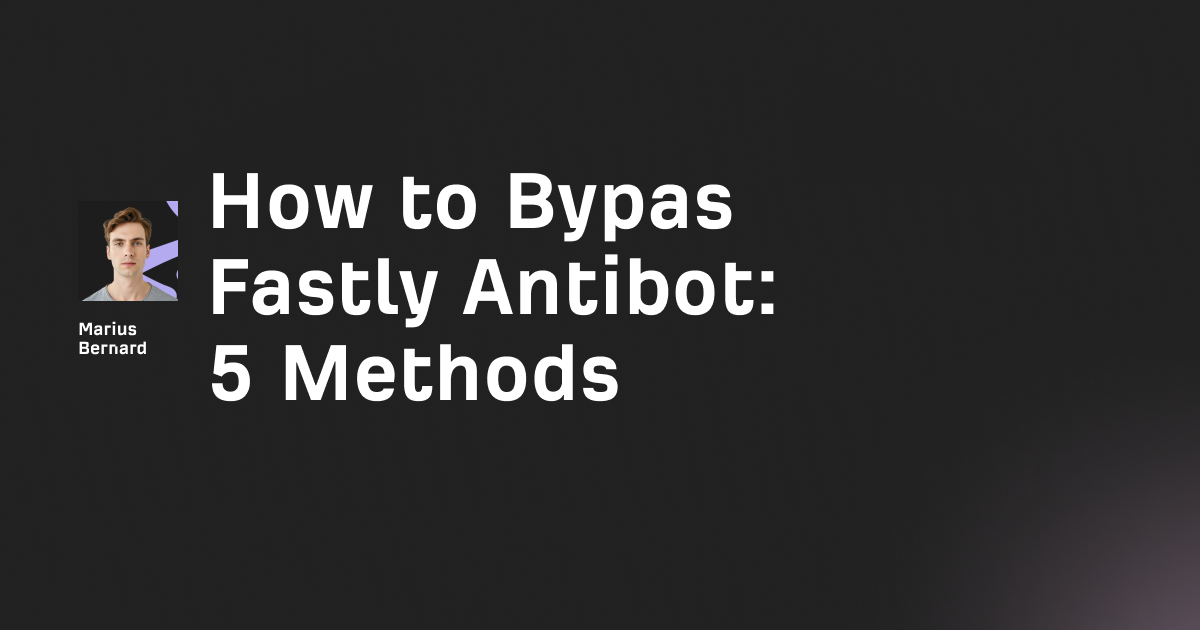Running into Cloudflare's roadblocks while trying to access data for your project? You’re not alone. Many developers, analysts, and researchers quickly discover that Cloudflare’s bot protection isn’t just a mild inconvenience—it’s a full-on gatekeeper.
But here’s the good news: with the right strategy, you can bypass these defenses responsibly. The key is obtaining the cf_clearance cookie—the golden ticket Cloudflare assigns to legit browser sessions.
This guide walks you step-by-step through a proven, hands-on method to extract these cookies using automation. We’ve used it successfully across thousands of Cloudflare-protected sites for projects ranging from research and testing to business intelligence and compliance monitoring.
Why You Can Trust This Method
If you’ve ever hit a wall with Cloudflare while trying to gather public data, you know how frustrating it can be.
This guide is built on techniques used by top-tier scraping and data aggregation tools—strategies that simulate real user behavior and navigate Cloudflare’s layered defenses. These aren’t theoretical methods. They’ve been tested at scale across a wide variety of use cases.
Bottom line: If you're looking for a reliable way to get cf_clearance cookies without triggering alarms, this method delivers.
Step 1: Understand Cloudflare's Protection Mechanisms
Before you start coding, it helps to understand exactly what you’re up against. Cloudflare’s security stack uses a mix of browser checks, network analysis, and behavior modeling to detect bots.
How Detection Works
Cloudflare analyzes several factors to decide if your session looks real or automated:
- Browser Fingerprinting: Everything from your screen resolution to installed fonts can flag you.
- TLS Fingerprinting: Cloudflare inspects how your browser connects at the network level.
- Behavioral Analysis: Real users move the mouse, type inconsistently, and pause between actions. Bots don’t—unless you tell them to.
- IP Reputation: Known data center IPs? You’re already on their radar.
- Rate Limiting: Rapid or repetitive requests often trigger a challenge.
Types of Challenges
Depending on how aggressive the site’s settings are, you might face:
- JavaScript Challenges that require solving a math puzzle invisibly
- Interactive Challenges like "I am not a robot" checkboxes
- Captcha Challenges—image puzzles meant to stop bots cold
- Managed Challenges that blend multiple defenses
Knowing what you’re likely to face helps you plan the right automation route.
Step 2: Set Up Your Browser Automation Environment
Here’s where your technical setup begins. To successfully pass Cloudflare’s checks, you’ll need an environment that behaves like a real human using a browser—not a script hitting an endpoint.
Choose Your Framework
Pick the tool that fits your tech stack:
Python Users:
# Install required packages
pip install undetected-chromedriver
pip install selenium-wire
pip install requests-html
JavaScript Developers:
# Install Playwright (recommended)
npm install playwright
npm install playwright-extra
npm install puppeteer-extra-plugin-stealth
Prefer Turnkey Solutions?
- FlareSolverr: A Docker-based Cloudflare solver that works across languages
- CF-Clearance-Scraper: Command-line tool purpose-built for cf_clearance extraction
Want a Simple Start? Use CF-Clearance-Scraper
# Clone the repository
git clone https://github.com/Xewdy444/CF-Clearance-Scraper
cd CF-Clearance-Scraper
# Install requirements (Python 3.10+ required)
pip3 install -r requirements.txtThis utility focuses on cf_clearance and gets the job done—fast. Just know it has limitations we’ll cover later.
A Solid Python Example: Undetected Chrome Setup
import undetected_chromedriver as uc
from selenium.webdriver.common.by import By
import time
import json
# Configure Chrome options for stealth
options = uc.ChromeOptions()
options.add_argument('--no-sandbox')
options.add_argument('--disable-dev-shm-usage')
options.add_argument('--disable-blink-features=AutomationControlled')
options.add_experimental_option("excludeSwitches", ["enable-automation"])
options.add_experimental_option('useAutomationExtension', False)
# Initialize driver
driver = uc.Chrome(options=options, version_main=None)
driver.execute_script("Object.defineProperty(navigator, 'webdriver', {get: () => undefined})")Or Go Service-Based: Install FlareSolverr
# Using Docker
docker run -d \
--name=flaresolverr \
-p 8191:8191 \
-e LOG_LEVEL=info \
--restart unless-stopped \
ghcr.io/flaresolverr/flaresolverr:latestThis creates an automated challenge-solver that’s language-agnostic and scalable.
Step 3: Configure Stealth Settings and Fingerprint Management
Now comes the art of deception: configuring your headless browser so that it doesn’t look... headless.
Essential Stealth Tweaks
Use browser flags that help you blend in:
# Advanced stealth settings
options.add_argument('--disable-web-security')
options.add_argument('--allow-running-insecure-content')
options.add_argument('--disable-extensions')
options.add_argument('--disable-plugins')
options.add_argument('--disable-images') # Optional: speeds up loading
options.add_argument('--no-first-run')
options.add_argument('--disable-default-apps')
# Randomize viewport size
import random
viewport_width = random.randint(1024, 1920)
viewport_height = random.randint(768, 1080)
options.add_argument(f'--window-size={viewport_width},{viewport_height}')Rotate Fingerprints
Randomize headers, user agents, and screen sizes to avoid becoming a repeat offender in Cloudflare’s logs:
def randomize_fingerprint(driver):
# Randomize user agent
user_agents = [
"Mozilla/5.0 (Windows NT 10.0; Win64; x64) AppleWebKit/537.36 (KHTML, like Gecko) Chrome/120.0.0.0 Safari/537.36",
"Mozilla/5.0 (Macintosh; Intel Mac OS X 10_15_7) AppleWebKit/537.36 (KHTML, like Gecko) Chrome/120.0.0.0 Safari/537.36",
"Mozilla/5.0 (X11; Linux x86_64) AppleWebKit/537.36 (KHTML, like Gecko) Chrome/120.0.0.0 Safari/537.36"
]
selected_ua = random.choice(user_agents)
driver.execute_cdp_cmd('Network.setUserAgentOverride', {
"userAgent": selected_ua
})
# Randomize screen resolution
driver.execute_cdp_cmd('Emulation.setDeviceMetricsOverride', {
'width': viewport_width,
'height': viewport_height,
'deviceScaleFactor': round(random.uniform(1.0, 2.0), 1),
'mobile': False
})Mimic Human Behavior
Time to act like a human—not a machine:
def human_delay():
"""Simulate human-like delays"""
time.sleep(random.uniform(1.5, 4.0))
def random_mouse_movement(driver):
"""Simulate random mouse movements"""
from selenium.webdriver.common.action_chains import ActionChains
actions = ActionChains(driver)
for _ in range(random.randint(2, 5)):
x_offset = random.randint(-100, 100)
y_offset = random.randint(-100, 100)
actions.move_by_offset(x_offset, y_offset)
actions.perform()
time.sleep(random.uniform(0.1, 0.5))These subtle behaviors can dramatically improve your odds of avoiding blocks.
Step 4: Solve JavaScript Challenges and Captchas
This is where most automation breaks. But if you’ve configured stealth correctly, you're already halfway there.
Handle JavaScript Challenges with Grace
def solve_cloudflare_challenge(driver, url, timeout=30):
"""Automatically solve Cloudflare JavaScript challenges"""
driver.get(url)
human_delay()
# Check if we hit a Cloudflare challenge
if "Just a moment" in driver.page_source or "Checking your browser" in driver.page_source:
print("Cloudflare challenge detected, waiting for resolution...")
# Wait for challenge to complete
start_time = time.time()
while time.time() - start_time < timeout:
try:
# Check if challenge is resolved
if driver.current_url != url and "cloudflare" not in driver.current_url.lower():
print("Challenge solved successfully!")
break
# Look for completion indicators
if "ray id" not in driver.page_source.lower():
break
except Exception as e:
print(f"Error checking challenge status: {e}")
time.sleep(2)
# Perform random mouse movements during wait
if "Just a moment" in driver.page_source:
random_mouse_movement(driver)
return driver.current_url == url or "cloudflare" not in driver.current_url.lower()Need to Interact? Checkbox and Slider Solutions
def handle_interactive_challenge(driver):
"""Handle Cloudflare interactive challenges"""
try:
# Look for challenge checkbox
checkbox = driver.find_elements(By.CSS_SELECTOR, 'input[type="checkbox"]')
if checkbox:
print("Found challenge checkbox, clicking...")
checkbox[0].click()
human_delay()
return True
# Look for slider challenge
slider = driver.find_elements(By.CSS_SELECTOR, '.slider, .challenge-slider')
if slider:
print("Found slider challenge, solving...")
ActionChains(driver).click_and_hold(slider[0]).move_by_offset(100, 0).release().perform()
human_delay()
return True
except Exception as e:
print(f"Error handling interactive challenge: {e}")
return FalseFor Captchas, Bring in Backup
You’ll need a service like 2captcha to handle image-based tests:
def solve_captcha_with_service(driver, api_key):
"""Solve captchas using 2captcha or similar service"""
try:
# Find captcha element
captcha_element = driver.find_element(By.CSS_SELECTOR, '.cf-captcha, .h-captcha')
if captcha_element:
# Extract site key
site_key = captcha_element.get_attribute('data-sitekey')
# Submit to solving service (pseudocode)
captcha_solution = submit_to_captcha_service(
site_key=site_key,
page_url=driver.current_url,
api_key=api_key
)
# Apply solution
driver.execute_script(f"document.getElementById('h-captcha-response').innerHTML='{captcha_solution}';")
# Submit form
submit_button = driver.find_element(By.CSS_SELECTOR, 'input[type="submit"], button[type="submit"]')
submit_button.click()
return True
except Exception as e:
print(f"Error solving captcha: {e}")
return FalseOr Let CF-Clearance-Scraper Handle It
import subprocess
import re
def cf_clearance_scraper(url, proxy, user_agent):
"""Use CF-Clearance-Scraper tool to get cf_clearance cookie"""
command = [
"python",
"main.py",
"-p", proxy,
"-t", "60", # 60 second timeout
"-ua", user_agent,
"-f", "cookies.json",
url,
]
try:
# Run the command and capture output
process = subprocess.run(
command,
stdout=subprocess.PIPE,
stderr=subprocess.STDOUT,
text=True,
)
output = process.stdout
# Extract cf_clearance value from logs using regex
match = re.search(r"cf_clearance=([^\s]+)", output)
if match:
cf_clearance = match.group(1)
return cf_clearance
else:
print("Failed to extract cf_clearance from output")
return None
except Exception as e:
print(f"Error running CF-Clearance-Scraper: {e}")
return None
# Usage example
target_url = "https://example.com"
user_agent = "Mozilla/5.0 (Windows NT 10.0; Win64; x64) AppleWebKit/537.36"
proxy = "http://proxy-server:8080"
cf_clearance = cf_clearance_scraper(target_url, proxy, user_agent)
if cf_clearance:
print(f"Successfully obtained cf_clearance: {cf_clearance}")This method delegates the challenge-solving to a subprocess and extracts cf_clearance from the logs.
Step 5: Extract and Manage cf_clearance Cookies
Once you’ve made it past the gate, it’s time to grab the keys to the kingdom.
Extract the Cookie
def extract_cf_clearance_cookie(driver):
"""Extract cf_clearance and related cookies"""
cookies = {}
try:
# Get all cookies from the current session
all_cookies = driver.get_cookies()
for cookie in all_cookies:
cookie_name = cookie['name']
# Extract Cloudflare-related cookies
if cookie_name in ['cf_clearance', '__cf_bm', 'cf_chl_opt', '__cflb']:
cookies[cookie_name] = {
'value': cookie['value'],
'domain': cookie['domain'],
'path': cookie.get('path', '/'),
'expires': cookie.get('expiry'),
'secure': cookie.get('secure', False),
'httpOnly': cookie.get('httpOnly', False)
}
print(f"Extracted {len(cookies)} Cloudflare cookies")
return cookies
except Exception as e:
print(f"Error extracting cookies: {e}")
return {}Store for Later Use
def save_cookies_to_file(cookies, filename):
"""Save cookies to JSON file for persistence"""
try:
# Add timestamp for tracking
cookie_data = {
'timestamp': time.time(),
'cookies': cookies
}
with open(filename, 'w') as f:
json.dump(cookie_data, f, indent=2)
print(f"Cookies saved to {filename}")
except Exception as e:
print(f"Error saving cookies: {e}")
def load_cookies_from_file(filename):
"""Load previously saved cookies"""
try:
with open(filename, 'r') as f:
cookie_data = json.load(f)
# Check if cookies are still valid (not expired)
timestamp = cookie_data.get('timestamp', 0)
if time.time() - timestamp > 3600: # 1 hour expiry
print("Cookies are expired, need to refresh")
return None
return cookie_data['cookies']
except FileNotFoundError:
print("No saved cookies found")
return None
except Exception as e:
print(f"Error loading cookies: {e}")
return NoneUse Cookies for Requests (But Carefully)
Consistency is everything. You must use the same IP and User Agent that got the cookies in the first place.
import requests
def make_request_with_cookies(url, cookies, headers=None, proxy=None):
"""Make HTTP request using extracted cf_clearance cookies"""
session = requests.Session()
# Set default headers - MUST match the User Agent used to get cookies
if not headers:
headers = {
'User-Agent': 'Mozilla/5.0 (Windows NT 10.0; Win64; x64) AppleWebKit/537.36 (KHTML, like Gecko) Chrome/120.0.0.0 Safari/537.36',
'Accept': 'text/html,application/xhtml+xml,application/xml;q=0.9,image/webp,*/*;q=0.8',
'Accept-Language': 'en-US,en;q=0.5',
'Accept-Encoding': 'gzip, deflate',
'Connection': 'keep-alive',
'Upgrade-Insecure-Requests': '1',
}
session.headers.update(headers)
# Set proxy - MUST be the same IP used to obtain cookies
if proxy:
session.proxies.update({
'http': proxy,
'https': proxy
})
# Add cookies to session
for cookie_name, cookie_data in cookies.items():
session.cookies.set(
name=cookie_name,
value=cookie_data['value'],
domain=cookie_data['domain'],
path=cookie_data.get('path', '/')
)
try:
response = session.get(url, timeout=30)
if response.status_code == 200:
print(f"Successfully accessed {url}")
return response
else:
print(f"Request failed with status code: {response.status_code}")
return None
except Exception as e:
print(f"Error making request: {e}")
return NoneStep 6: Implement Session Persistence and Rotation
Got your cookie? Great. Now let’s keep it alive—and rotate when needed.
Automatic Refresh Strategy
class CloudflareCookieManager:
def __init__(self, target_url):
self.target_url = target_url
self.cookies = {}
self.last_refresh = 0
self.refresh_interval = 1800 # 30 minutes
def need_refresh(self):
"""Check if cookies need refreshing"""
return time.time() - self.last_refresh > self.refresh_interval
def refresh_cookies(self):
"""Refresh cf_clearance cookies"""
print("Refreshing Cloudflare cookies...")
# Setup fresh browser instance
options = uc.ChromeOptions()
self.configure_stealth_options(options)
driver = uc.Chrome(options=options)
try:
# Solve challenge and extract new cookies
if solve_cloudflare_challenge(driver, self.target_url):
self.cookies = extract_cf_clearance_cookie(driver)
self.last_refresh = time.time()
# Save for persistence
save_cookies_to_file(self.cookies, 'cf_cookies.json')
print("Cookies refreshed successfully")
return True
else:
print("Failed to refresh cookies")
return False
finally:
driver.quit()
def get_valid_cookies(self):
"""Get valid cookies, refreshing if necessary"""
if not self.cookies or self.need_refresh():
if not self.refresh_cookies():
return None
return self.cookiesRotate Proxies and Sessions
def rotate_proxy_and_session():
"""Rotate proxy servers and browser sessions"""
proxies = [
{'http': 'http://proxy1:8080', 'https': 'https://proxy1:8080'},
{'http': 'http://proxy2:8080', 'https': 'https://proxy2:8080'},
# Add more proxies
]
selected_proxy = random.choice(proxies)
# Configure Chrome with proxy
options = uc.ChromeOptions()
options.add_argument(f'--proxy-server={selected_proxy["http"]}')
return options
def implement_session_rotation(urls_to_scrape):
"""Rotate sessions across multiple URLs"""
session_managers = {}
for url in urls_to_scrape:
# Create separate cookie manager for each domain
domain = url.split('/')[2]
if domain not in session_managers:
session_managers[domain] = CloudflareCookieManager(f"https://{domain}")
return session_managersHealth Monitoring and Failover
def monitor_cookie_health(cookie_manager):
"""Monitor cookie validity and success rates"""
test_urls = [
cookie_manager.target_url,
f"{cookie_manager.target_url}/robots.txt"
]
success_count = 0
total_tests = len(test_urls)
cookies = cookie_manager.get_valid_cookies()
if not cookies:
return False
for url in test_urls:
response = make_request_with_cookies(url, cookies)
if response and response.status_code == 200:
success_count += 1
success_rate = success_count / total_tests
print(f"Cookie health: {success_rate:.1%} success rate")
# Refresh if success rate is too low
if success_rate < 0.5:
print("Low success rate, refreshing cookies...")
return cookie_manager.refresh_cookies()
return TrueDon’t wait for your scraping to fail—track session health and stay one step ahead.
Troubleshooting Common Issues
Even solid setups run into problems. Here’s how to fix the usual suspects:
1. Cookie Expiry Too Fast?
Increase delays and add warm-up behavior:
# Extend cookie lifetime with proper request spacing
def extend_cookie_lifetime():
time.sleep(random.uniform(10, 30)) # Longer delays
# Make occasional "keepalive" requests
make_request_with_cookies(f"{base_url}/favicon.ico", cookies)2. Detection Despite Stealth?
Make sure Chrome is current and diversify your fingerprint:
# Force Chrome version update
driver = uc.Chrome(version_main=120) # Specify latest version
# Enhanced fingerprint randomization
def advanced_fingerprint_randomization(driver):
# Randomize WebGL fingerprint
driver.execute_script('''
const getParameter = WebGLRenderingContext.prototype.getParameter;
WebGLRenderingContext.prototype.getParameter = function(parameter) {
if (parameter === 37445) {
return "Intel Inc.";
}
if (parameter === 37446) {
return "Intel(R) Iris(TM) Graphics 6100";
}
return getParameter.apply(this, arguments);
};
''')3. Captchas Constantly Appearing?
Try this:
- Use residential proxies
- Slow down scraping frequency
- Warm up the session with light browsing:
def warm_up_session(driver, base_url):
"""Warm up session to reduce captcha frequency"""
# Visit multiple pages slowly
warmup_pages = ['/about', '/contact', '/privacy']
for page in warmup_pages:
try:
driver.get(f"{base_url}{page}")
time.sleep(random.uniform(5, 15))
random_mouse_movement(driver)
except:
continue4. Memory Leaks and Crashes?
Clean up after your browser sessions:
def cleanup_browser_resources():
"""Properly cleanup browser resources"""
try:
driver.delete_all_cookies()
driver.execute_script("window.localStorage.clear();")
driver.execute_script("window.sessionStorage.clear();")
finally:
driver.quit()
# Restart browser every N requests
request_count = 0
MAX_REQUESTS_PER_SESSION = 50
if request_count >= MAX_REQUESTS_PER_SESSION:
cleanup_browser_resources()
driver = create_new_browser_instance()
request_count = 0Restart automation regularly to stay lean and stable.
5. CF-Clearance-Scraper Failing?
Sticky proxies and cookie validation checks help:
# Use sticky sessions with proxy services
def configure_sticky_proxy(session_id, duration_minutes=10):
"""Configure proxy with sticky session to maintain IP consistency"""
proxy_url = f"http://username:password_session-{session_id}_ttl-{duration_minutes}m@proxy-server:port"
return {
'http': proxy_url,
'https': proxy_url
}
# Implement cookie health monitoring
def monitor_cookie_validity(cookies, test_url):
"""Monitor if cookies are still valid"""
test_response = make_request_with_cookies(test_url, cookies)
if test_response and "challenge" not in test_response.text.lower():
return True
else:
print("Cookies appear to be invalid, refresh needed")
return FalseFinal Thoughts
At the heart of all this is a simple truth: if your session looks real and behaves consistently, you can bypass Cloudflare protections with ease.
Key things to remember:
- Your IP + User Agent combo must stay identical from cookie generation to request
- Delay and randomness are your allies
- Always save and refresh cookies proactively
- Never rely on tools alone—monitor and adapt constantly
Used correctly, these strategies let you access Cloudflare-protected sites safely and reliably, without resorting to brittle hacks or sketchy services.








